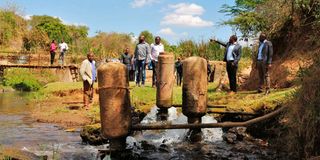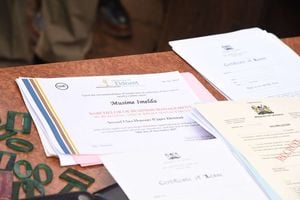Machakos businessman counts on pump to boost food production in semi-arid region

Yatta MP Robert Ngui, (second right) has pledged to help upscale the pump.
From the outside, Daniel Mutinda’s workshop at the heart of Ndalani Township in Machakos County looks ordinary.
A closer look, however, reveals that it is no ordinary workspace. Inside, a team of artisans use recycled gas cylinders and car tyres to produce matumbi, the local name for custom-made hydraulic ram (hydram) water pumps which are powered by water.
“We utilise used gas cylinders and car tyres to make hydram pumps - we install a long thick galvanised steel pipe at a gradient to speed water into the pump. The speed of water increases its force as it enters the pump,” Mutinda explains, displaying mastery of Bernoulli’s principle, the scientific underpinning of the hydram pump.
Daniel Bernoulli, a Swiss mathematician and physicist, discovered that the pressure within a moving fluid decreases when its speed increases.
“The hydram pump works through converting the kinetic energy of speeding water to pressure energy, which pumps out water to high attitudes and long distances through a narrow delivery pipe fixed on the vacuum chamber,” adds Lawrence Matolo, the chairman of Inventors and Innovators Association of Kenya, and also a science lecturer at Machakos University.
Hydram technology
Although hydram water pumps were introduced into the country during the colonial era, generators powered by petrol, diesel, electricity and solar have since overshadowed hydram technology.
Weary of the skyrocketing cost of fuel and high maintenance costs of the popular diesel pumps, dozens of residents of Yatta and Mwala regions in Machakos County are, however, embracing this technology. Mutinda's ingenuity is behind a growing uptake of hydram pumps in the semi-arid region.
“In the last eight years, we have installed more than 300 hydram pumps in the rivers Athi, Thika and Languni. This has boosted entrepreneurship,” offers Mutinda.

Daniel Mutinda (left) oversees the fabrication of a water pump at his workshop in Ndalani Township in Machakos County. Farmers using this technology to farm report improved production.
His clients include a team of businessmen based at Kabaa Township. They use hydram pumps to draw water from River Athi for irrigation besides selling the commodity to the community. They are inspired by Kabaa High School which has operated this kind of pump to draw water from River Athi for more than 50 years. In the neighbouring Ndalani region, many of the farmlands teem with lush crops throughout the year, and many of the farmers have installed hydram pumps which they use to irrigate their crops. They have defied agronomists, who recommend drip irrigation to preserve water.
“Water is not a big deal here,” says Joshua Kimina, a former policeman who is now a full time farmer.
He keeps dairy cattle and grows sugarcane, maize, cabbage and kale for sale and for domestic consumption. He is among dozens of local farmers who have installed hydram pumps at River Languni, which snakes through the sleepy region.
The hydram pump is a big deal in the semi-arid region ravaged by prolonged droughts and wanton sand harvesting activities that have destroyed many rivers and compromised the resilience of locals to the adverse effects of climate change.
The pump is placed on the edges of a river course to minimise chances of the pump being submerged when the river swells. In some cases, the pump is housed in a concrete cage so that it is not submerged when the river swells.
“We firmly fix the pumps onto rocks in the river bed to ensure they are not washed away during the rainy season,” explains Mutinda, who credits Mzee Amos Ng’ang’a for his fabrication skills.
Formal training
Although Mutinda has not received any formal training in engineering, he is good at his job. After completing primary school, he worked as an apprentice at a workshop located at Ndalani Township.
Then he took a beaten path; fabricating metal doors and windows under various employers.
This is how he met Mzee Ng’ang’a, a veteran artisan who has been producing hydram pumps for years in the region. The elderly man, who has since retired to his home at Kiwanzani Village in Mavoloni region of Machakos County, having mentored many, worked closely with the Europeans in servicing hydram pumps, and within a short time, he mastered the skill. Over the years, he honed his knowledge on the technology.
He charges at least Sh200,000 to fabricate and install a pump. The cost varies depending on the distance the pump is expected to deliver water. The bulk of the cost of a hydram pump goes to buying heavy duty galvanised steel pipes.

Daniel Mutinda shows a section of hydram water pumps installed at the section of River Ianguni which passes through Kitunenei Village in Machakos County on October 5, 2022.
Yatta MP, Robert Ngui, bets big on the technology to unlock the region’s economic potential through addressing food insecurity and joblessness among the youth.
“It is a surprise to have a green energy model technology which has stuck. This should be the best technology in the world. The technology guarantees a continuous and sustainable water supply which is not hazardous to the environment. I will upscale the hydram pump technology to address food insecurity and joblessness among young people. We shall be able to grow food through irrigated agriculture and source a market for the farmers,” he says, adding,
“I am looking at nearby schools. Schools should get food from farmers and convert that to bursaries. Instead of depending on bursaries to pay school fees for their children, farmers can instead provide schools with farm produce. That will ease the burden experience by households,” he said recently when he visited Mutinda’s workshop in the company of Kenya Climate Innovation Center officials.





